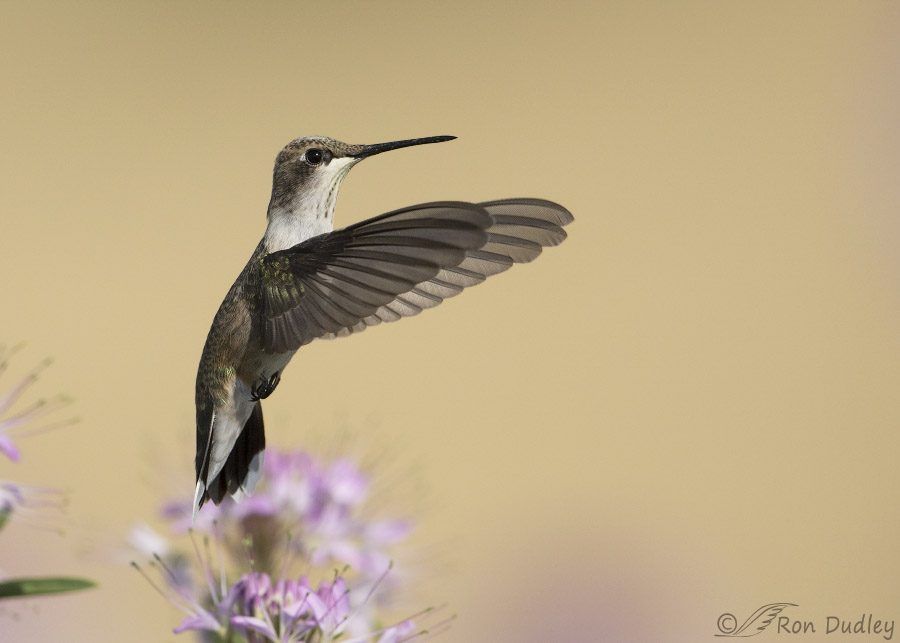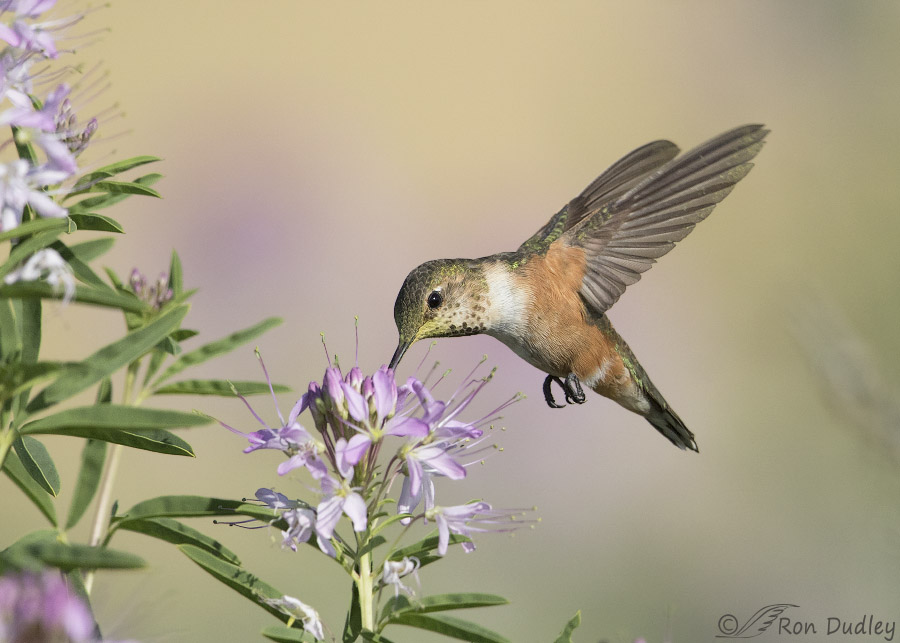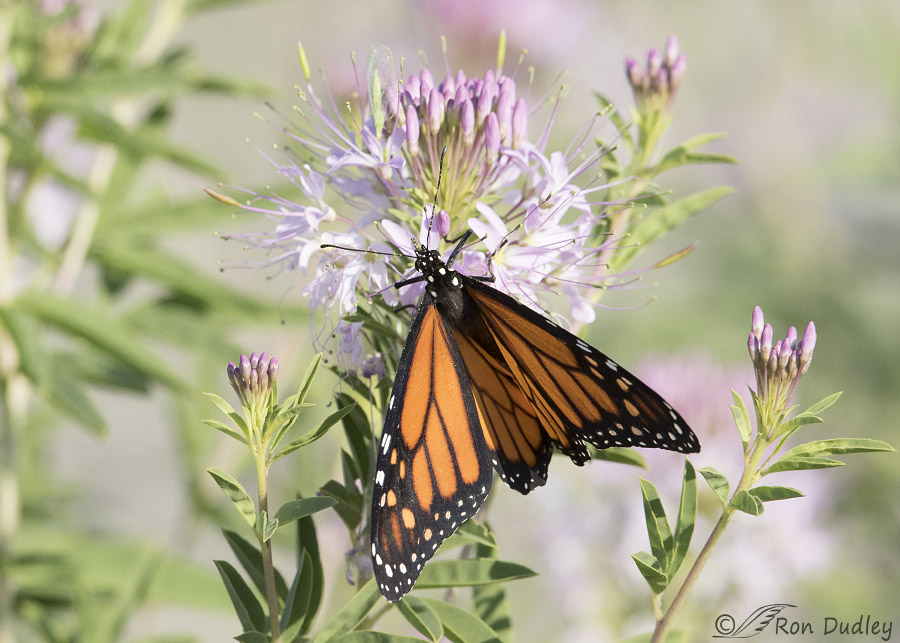Regular readers know that I prefer to photograph birds in natural settings and that includes hummingbirds. For a variety of reasons hummingbirds are often easily photographed at setups or back yard feeders but that just isn’t my style. Largely for that reason I don’t post hummingbird photos very often because finding them in a natural setting where they can be photographed well isn’t easy.
Three years ago I had a blast for several days shooting hummers as they fed on the nectar of Rocky Mountain Bee Plant – also known as stinkweed, stinking clover and Navajo spinach . This member of the Cleome genus has an unpleasant smell but it’s flower clusters attract a variety of pollinators including hummingbirds. Since the plant seemed so productive for hummers I looked for it often over the last two years but patches of it were unusually scarce and when I did find one there were never any hummingbirds on it.
But yesterday morning I finally found both – hummers and bee plant. Because of the topography I couldn’t get quite as close as I’d have liked but I still got a few shots I enjoyed. These are two of them.

1/8000, f/5.6, ISO 640, Canon 7D Mark II, Canon EF 500mm f/4L IS II USM + EF 1.4 III Extender, not baited, set up or called in
There were several species feeding on the nectar and I believe this one is a Black-chinned Hummingbird, possibly a young male, but my hummer ID skills are sadly lacking and I can’t be sure. There’s not a lot of color showing in the bird but I liked the pose and the mostly clean background.
One of the things I really appreciate about my lens is that it’s fast enough (f/4) to get shutter speeds that are plenty fast enough to freeze even hummingbird wings in natural light (without flash). I refuse to use flash on birds – that’s just a thing of mine, partly because it seems like such an incredibly rude thing to do. Here I even had significantly more SS than I needed and that was with the teleconverter attached.

1/6400, f/5.6, ISO 800, Canon 7D Mark II, Canon EF 500mm f/4L IS II USM + EF 1.4 III Extender, not baited, set up or called in
The most common species on the flower patch was Rufous Hummingbirds – a favorite of mine.
The Rufous Hummingbird is known as North America’s “extremist” hummingbird because of its unusually aggressive nature, even for a hummer. I saw these birds chase off several other hummingbirds of at least two species and they often do the same thing to large pollinating insects like sphinx moths.
But I did see one thing that took me aback yesterday – an insect that chased off a rufous.

It was one of the many monarch butterflies feeding at the patch. The butterfly came in deliberately and aggressively toward the hummer and chased it off of a flower, I’m quite sure of it.
And that definitely surprised me.
Ron


These are just beautiful! Thank you for not calling, baiting or setting up. I don’t know too many photographers who don’t use one or more of these methods so I appreciate and respect your work.
On this side of the world our Orchard butterlies can be aggressive. They have even been reported as chasing off magpies . I can’t believe that ends well for the aggressor.
I am very happy to see your hummers again and echo the applause posture adopted in the first image you gave us today.
Gotta admire anything that would look like bird droppings in their larval stage as a survival strategy. And interesting that they are so aggressive toward anything black and white like they are, including magpies. Thanks for that tidbit, EC.
It blew me away when I first read how aggressive they are. And yes, I smiled at looking like droppings as a survival technicque too.
Forgot to mention the thing about looking like bird droppings. Nobody but the dung beetles want to mess with poop, so that’s an excellent strategy! YAY!
YIKES EC!! Talk about delusions of grandeur! But you folks have a lot of really weird critters there (so do we, but…)! LOL!
Yet again, here’s an OH WOW bunch of images (she said ridiculously redundantly!). Hummers are just outrageously wonderful and seriously magical! I managed to encourage both ruby-throated hummers and chickadees and their pals, tufted titmice (titmouses?) to my hand to feed when I lived in Dallas–another lesson in trust and being trustWORTHY! What a delight! At this point in my life, I choose to populate it with those with high ethical and moral standards. Life is good that way
At this point in my life, I choose to populate it with those with high ethical and moral standards. Life is good that way 
There was also Annabelle Lee, the fox squirrel who one day climbed up my jeans on my right side looking for her sunflower seeds when I had Mariah (redtail hawk) on my left fist. That was initially scary, but Mariah wasn’t even a little bit interested in squirrels in her first year…later she learned to be lethal with them, but thankfully not THAT day! Phrew!
And once again, I’m thoroughly impressed with your overall ethics in the field. You’re my kind of person! Yes, it makes the task far more complicated and difficult, but that you care about the welfare of the birds/critters you photograph and their environment thrills my soul…seriously. It’s one of the many reasons I’m here as long as you are! Or as long as I can keep an Internet connection going.
Ha, I’ve often also wondered about what the plural was for titmouse, Laura. That and a few others.
Love that second photo of the Rufous Humming bird. It’s so beautiful.
Thank you, Joanne.
Who knew that jewels could fly!!! These are incredible images!!! Love them all….
I’m pretty sure the Monarch deliberately challenged snd chased the hummer away…my husband and I saw a tiger swallowtail and a hummingbird having a stand off over some verbena in a flower box…couldn’t believe our eyes…esoecially when the butterfly won!!!
Thanks, Patty. I saw the same behavior again this morning.
WOW! Really great photos.
Thanks, Len.
Two of my most favorite species on the planet! Superb photos, as always!
Thank you, Nicole.
I love all birds and other flying things. However hummingbirds are my favorite. Thank you for these pictures they are wonderful. One of the most interesting and fun things I’ve observed is a hummingbird count in Idaho. Amazing little creatures.
They certainly are, Betty – in so many ways!
The butterfly had had enough. I like that it drove the hummer off.
I like that it drove the hummer off.
From what I can tell that first shot has to be a young juvenile. Black-chinned Hummingbirds are the only kind we have that nests here. We have a female who comes around fairly frequently and likes to look in our windows. She also always checks out a hanging planter that she clearly thinks should be a Humminbird feeder, but that won’t happen any time soon, if ever. Instead, we have some young desert willow trees that I grew from seed that bloom all summer long. To me that’s the best Hummingbird feeder. Both of your Hummbird photos are beautiful. I especially like the first one. I’ve never thought of butterflies as ever being aggressive, but I can see a Monarch doing that. As much as I am interested in insects, I’d rather see the Hummingbird win out.
Sounds like you have a peeping tom hummer, Susan!
Not the first time with a peeping tom hummer. When I lived in California I had Anna’s hummers who would hover in front of me when I was sitting on my front porch. They would also hover in front of my open window and watch me put clean sheets on my bed. This was a regular activity for them.
Thank you for not using flash on birds. I can’t imagine how disruptive that would be to a bird’s navigation. I really like the first image because of the unusual wing position and the slight softness of the flowers behind him.
Between our neighbor’s coral tree and all the bird of paradise plants we have in our yard, I’m very fortunate to see several varieties of hummingbirds and butterflies on a regular basis. I’ve never seen the kind of butterfly badassery you’ve described, though!
Marty, I never have and never will use flash on a bird. I think it’s rude, among other objections I have to the practice generally.
Ron, your second image is the type all us would-be bird photographers dream of capturing! Great depth of field (flower and hummer), frozen action, wonderful background, great lighting, catch light, . . . Thank you so much for sharing.
I’m glad you like that shot so much, Ron. I feel somewhat similar about it. Thanks.
Lovely ! Especially enjoyed the little “fan dancer” in the first shot, and was surprised to learn that ANY critter could cow a rufous . In the last week, I’ve spotted 3 Monarchs which appear to be migrating
—–flying high over highways, away from vegetation and heading southwest—-quite early ! Wondering if anybody else has noticed this ?
I haven’t noticed theme migrating, Kris, but I did see more of them this morning at the patch.
Cool! We get a couple of Rufus in the fall for a few days – they are SO fun to watch.:) They do get them at higher elevations in the vicinity during the summer. It is amazing that the Monarch would chase off the hummingbird particularly when I know the Rufus are aggressive. Always something to learn. Glad you were able to capture them.
Judy, Rufous seem to be our most common hummer down here.
Beautiful Ron!
Charlotte
Thanks, Charlotte.
Hi Ron, Great photos! I volunteer at a Butterfly habitat in central Illinois. Our habitat is enclosed but we have bee balm planted on the outside of it. I have observed Tiger swallowtails and other swallowtails chasing hummingbirds from their spot which has also greatly surprised me. I would think those little birds would be more than a match for a butterfly. I have also seen the swallowtails chase the monarchs away.
Interesting to know, Cindy. This might be the first time I’ve seen the behavior but then I don’t spend an extraordinary amount of time photographing hummingbirds.